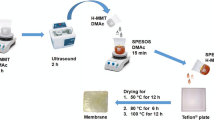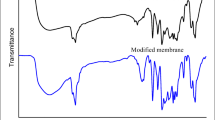Abstract
Herein, we are reporting the carbon nano onions (CNO)-based sulphonated poly(ethersulfone) (SPES) composite membranes by varying CNO content in SPES matrix for water desalination applications. CNOs were cost-effectively synthesized using flaxseed oil as a carbon source in an energy efficient flame pyrolysis process. The physico- and electrochemical properties of nanocomposite membranes were evaluated and compared to pristine SPES. Moreover, the chemical characterisation of composite membranes and CNOs were illustrated using techniques such as nuclear magnetic resonance (NMR), Fourier transform infrared spectroscopy (FT-IR), field emission scanning electron microscope (FE-SEM), thermogravimetric analysis (TGA) and universal tensile machine (UTM). In the series of nanocomposite membranes, SPES-0.25 composite membrane displayed the highest water uptake (WU), ion exchange membrane (IEC) and ionic conductivity (IC) values that were enhanced by 9.25%, ~ 44.78% and ~ 6.10%, respectively, compared to pristine SPES membrane. The electrodialytic performance can be achieved maximum when membranes possess low power consumption (PC) and high energy efficiency (Ee). Therefore, the value of Ee and Pc for SPES-0.25 membrane has been determined to be 99.01 ± 0.97% and 0.92 ± 0.01 kWh kg−1, which are 1.12 and 1.11 times higher than the pristine SPES membrane. Hence, integrating CNO nanoparticles into the SPES matrix enhanced the ion-conducting channels.







Similar content being viewed by others
Data Availability
All data and materials reported in the manuscripts are available.
References
Ahlawat J, Masoudi Asil S, Guillama Barroso G et al (2021) Application of carbon nano onions in the biomedical field: recent advances and challenges. Biomater Sci 9:626–644. https://doi.org/10.1039/D0BM01476A
Cao Y-C, Xu C, Wu X et al (2011) A poly (ethylene oxide)/graphene oxide electrolyte membrane for low temperature polymer fuel cells. J Power Sources 196:8377–8382. https://doi.org/10.1016/j.jpowsour.2011.06.074
Choi BG, Hong J, Park YC et al (2011) Innovative polymer nanocomposite electrolytes: nanoscale manipulation of ion channels by functionalized graphenes. ACS Nano 5:5167–5174. https://doi.org/10.1021/nn2013113
Divya K, Sri Abirami Saraswathi MS, Alwarappan S et al (2018) Sulfonated poly (ether sulfone)/poly (vinyl alcohol) blend membranes customized with tungsten disulfide nanosheets for DMFC applications. Polymer (Guildf) 155:42–49. https://doi.org/10.1016/j.polymer.2018.09.010
Fornasiero F, Park HG, Holt JK et al (2008) Ion exclusion by sub-2-nm carbon nanotube pores. Proc Natl Acad Sci 105:17250–17255. https://doi.org/10.1073/pnas.0710437105
Gahlot S, Sharma PP, Gupta H et al (2014a) Preparation of graphene oxide nano-composite ion-exchange membranes for desalination application. RSC Adv 4:24662–24670. https://doi.org/10.1039/C4RA02216E
Gahlot S, Sharma PP, Kulshrestha V, Jha PK (2014b) SGO/SPES-based highly conducting polymer electrolyte membranes for fuel cell application. ACS Appl Mater Interfaces 6:5595–5601. https://doi.org/10.1021/am5000504
Gahlot S, Sharma PP, Kulshrestha V (2015) Dramatic improvement in ionic conductivity and water desalination efficiency of SGO composite membranes. Sep Sci Technol 50:446–453. https://doi.org/10.1080/01496395.2014.973525
Gahlot S, Gupta H, Jha PK, Kulshrestha V (2017) Enhanced electrochemical performance of stable SPES/SPANI composite polymer electrolyte membranes by enriched ionic nanochannels. ACS Omega 2(9):5831–5839. https://doi.org/10.1021/acsomega.7b00687
Gahlot S, Sharma PP, Yadav V et al (2018) Nanoporous composite proton exchange membranes: High conductivity and thermal stability. Colloids Surf A Physicochem Eng Asp 542:8–14. https://doi.org/10.1016/j.colsurfa.2018.01.039
Gahlot S, Yadav V, Sharma PP, Kulshrestha V (2019) Zn-MOF@SPES composite membranes: synthesis, characterization and its electrochemical performance. Sep Sci Technol 54:377–385. https://doi.org/10.1080/01496395.2018.1505916
Ganesh BM, Isloor AM, Ismail AF (2013) Enhanced hydrophilicity and salt rejection study of graphene oxide-polysulfone mixed matrix membrane. Desalination 313:199–207. https://doi.org/10.1016/j.desal.2012.11.037
Jaroszek H, Dydo P (2016) Ion-exchange membranes in chemical synthesis – a review. Open Chem 14:1–19. https://doi.org/10.1515/chem-2016-0002
Jung S, Myung Y, Das GS et al (2020) Carbon nano-onions from waste oil for application in energy storage devices. New J Chem 44:7369–7375. https://doi.org/10.1039/D0NJ00699H
Kannan R, Kakade BA, Pillai VK (2008) Polymer electrolyte fuel cells using Nafion-based composite membranes with functionalized carbon nanotubes. Angew Chem Int Ed 47:2653–2656. https://doi.org/10.1002/anie.200704343
Kulshrestha V, Chatterjee U, Sharma S et al (2015) Large scale preparation of polyethylene based ion exchange membranes and their application for water desalination. Macromol Symp 357:194–199. https://doi.org/10.1002/masy.201400243
Kumari P, Tripathi KM, Jangir LK et al (2021) Recent advances in application of the graphene-based membrane for water purification. Mater Today Chem 22:100597. https://doi.org/10.1016/j.mtchem.2021.100597
Kumari P, Tripathi KM, Awasthi K, Gupta R (2022) Sustainable carbon nano-onions as an adsorbent for the efficient removal of oxo-anions. Environ Sci Pollut Res 30:15480–15489. https://doi.org/10.1007/s11356-022-22883-3
Kumari P, Tripathi KM, Awasthi K et al (2023) Biomass-derived carbon nano-onions for the effective elimination of organic pollutants and oils from water. Environ Sci Pollut Res 30:71048–71062. https://doi.org/10.1007/s11356-023-27457-5
Li W, Krantz WB, Cornelissen ER et al (2013) A novel hybrid process of reverse electrodialysis and reverse osmosis for low energy seawater desalination and brine management. Appl Energy 104:592–602. https://doi.org/10.1016/j.apenergy.2012.11.064
Lim Y, Lee S, Jang H et al (2014) Sulfonated poly(ether sulfone) electrolytes structured with mesonaphthobifluorene graphene moiety for PEMFC. Int J Hydrogen Energy 39:1532–1538. https://doi.org/10.1016/j.ijhydene.2013.08.002
Luo N, Xiang J-X, Shen T et al (2019) One-step gas-liquid detonation synthesis of carbon nano-onions and their tribological performance as lubricant additives. Diam Relat Mater 97:107448. https://doi.org/10.1016/j.diamond.2019.107448
Mishra S, Sharma J, Rathod NH, Kulshrestha V (2022) Solution-phase intercalation of 2D hybrid SGO in sulfonated poly(2,6-dimethyl-1,4-phenylene oxide): improved electrochemical properties and electrodialytic desalination performance. ACS Appl Energy Mater 5:4850–4860. https://doi.org/10.1021/acsaem.2c00263
Moussa G, Matei Ghimbeu C, Taberna P-L et al (2016) Relationship between the carbon nano-onions (CNOs) surface chemistry/defects and their capacitance in aqueous and organic electrolytes. Carbon N Y 105:628–637. https://doi.org/10.1016/j.carbon.2016.05.010
Nataraj SK, Hosamani KM, Aminabhavi TM (2007) Potential application of an electrodialysis pilot plant containing ion-exchange membranes in chromium removal. Desalination 217:181–190. https://doi.org/10.1016/j.desal.2007.02.012
Nouh EAS, Roy M, Nandi G, Sarkar S (2013) Magnetic and electrocatalytic properties of nano-Pd and -Pt-carbon nano-onion composite. Adv Sci Eng Med 5:1181–1187. https://doi.org/10.1166/asem.2013.1409
Panagopoulos A (2022a) Brine management (saline water & wastewater effluents): sustainable utilization and resource recovery strategy through minimal and zero liquid discharge (MLD & ZLD) desalination systems. Chem Eng Process - Process Intensif 176:108944. https://doi.org/10.1016/j.cep.2022.108944
Panagopoulos A (2022b) Techno-economic assessment and feasibility study of a zero liquid discharge (ZLD) desalination hybrid system in the Eastern Mediterranean. Chem Eng Process - Process Intensif 178:109029. https://doi.org/10.1016/j.cep.2022.109029
Panagopoulos A (2022c) Process simulation and analysis of high-pressure reverse osmosis (HPRO) in the treatment and utilization of desalination brine (saline wastewater). Int J Energy Res 46:23083–23094. https://doi.org/10.1002/er.8607
Panagopoulos A, Giannika V (2022a) Comparative techno-economic and environmental analysis of minimal liquid discharge (MLD) and zero liquid discharge (ZLD) desalination systems for seawater brine treatment and valorization. Sustain Energy Technol Assess 53:102477. https://doi.org/10.1016/j.seta.2022.102477
Panagopoulos A, Giannika V (2022b) Decarbonized and circular brine management/valorization for water & valuable resource recovery via minimal/zero liquid discharge (MLD/ZLD) strategies. J Environ Manage 324:116239. https://doi.org/10.1016/j.jenvman.2022.116239
Plonska-Brzezinska ME (2019) Carbon nano-onions: a review of recent progress in synthesis and applications. ChemNanoMat 5:568–580. https://doi.org/10.1002/cnma.201800583
Rajput A, Yadav V, Sharma PP, Kulshrestha V (2018) Synthesis of SGO composite interpenetrating network (CIPN) cation exchange membranes: stability and salt removal efficiency. J Memb Sci 564:44–52. https://doi.org/10.1016/j.memsci.2018.07.004
Rajput A, Raj SK, Lebedeva OV et al (2021) Functionalized carbon dots composite cation exchange membranes: improved electrochemical performance and salt removal efficiency. Colloids Surf A Physicochem Eng Asp 609:125677. https://doi.org/10.1016/j.colsurfa.2020.125677
Rathod NH, Upadhyay P, Pal S, Kulshrestha V (2023) Highly cross-linked butene grafted poly (vinyl alcohol)–co-vinyl pyridine based anion exchange membrane for improved acid recovery and desalination efficiency. Sep Purif Technol 308:122895. https://doi.org/10.1016/j.seppur.2022.122895
Sharma S, Bhattacharya A (2017) Drinking water contamination and treatment techniques. Appl Water Sci 7:1043–1067. https://doi.org/10.1007/s13201-016-0455-7
Sharma PP, Yadav V, Rajput A, Kulshrestha V (2018) Synthesis of chloride-free potash fertilized by ionic metathesis using four-compartment electrodialysis salt engineering. ACS Omega 3:6895–6902. https://doi.org/10.1021/acsomega.8b01005
Sonkar SK, Roy M, Babar DG, Sarkar S (2012) Water soluble carbon nano-onions from wood wool as growth promoters for gram plants. Nanoscale 4:7670. https://doi.org/10.1039/c2nr32408c
Thakur AK, Gahlot S, Kulshrestha V, Shahi VK (2013) Highly stable acid–base complex membrane for ethanol dehydration by pervaporation separation. RSC Adv 3:22014. https://doi.org/10.1039/c3ra40977e
Tripathi KM, Bhati A, Singh A et al (2016) From the traditional way of pyrolysis to tunable photoluminescent water soluble carbon nano-onions for cell imaging and selective sensing of glucose. RSC Adv 6:37319–37329. https://doi.org/10.1039/C6RA04030F
Tyagi A, Tripathi KM, Gupta RK (2015) Recent progress in micro-scale energy storage devices and future aspects. J Mater Chem A Mater 3:22507–22541. https://doi.org/10.1039/C5TA05666G
Venkatesan RA, Balachandran M (2020) Novel carbon nano-onions from paraffinum liquidum for rapid and efficient removal of industrial dye from wastewater. Environ Sci Pollut Res 27:43845–43864. https://doi.org/10.1007/s11356-020-09981-w
Widhyahrini K, Handayani N, Wahyuningrum D, Radiman CL (2020) The synthesis of sulfonated polyethersulfone (SPES) and the preparation of its membranes as matrix in the immobilization of Candida antarctica lipase B (Cal-B). Polym Bull 77:3735–3748. https://doi.org/10.1007/s00289-019-02932-7
Yadav V, Rajput A, Kulshrestha V (2020) Sulfonated poly(ether sulfone) based sulfonated molybdenum sulfide composite membranes and their applications in salt removal and alkali recovery. J Memb Sci 603:118043. https://doi.org/10.1016/j.memsci.2020.118043
Yadav V, Rathod NH, Sharma J, Kulshrestha V (2021) Long side-chain type partially cross-linked poly(vinylidene fluoride-co-hexafluoropropylene) anion exchange membranes for desalination via electrodialysis. J Memb Sci 622:119034. https://doi.org/10.1016/j.memsci.2020.119034
Zhang M, Zhao N, Sha J et al (2014) Synthesis of novel carbon nano-chains and their application as supercapacitors. J Mater Chem A 2:16268–16275. https://doi.org/10.1039/C4TA02623C
Zhao J, Guo L, Wang J (2018) Synthesis of cation exchange membranes based on sulfonated polyether sulfone with different sulfonation degrees. J Memb Sci 563:957–968. https://doi.org/10.1016/j.memsci.2018.05.023
Zhou M, Li Q, Zhong S et al (2017) Facile large scale fabrication of magnetic carbon nano-onions for efficient removal of bisphenol A. Mater Chem Phys 198:186–192. https://doi.org/10.1016/j.matchemphys.2017.05.020
Acknowledgements
The authors are thankful to MRC, MNIT Jaipur, for the characterization facilities.
Funding
IUAC, New Delhi, provided the financial support [UFR 56321].
Author information
Authors and Affiliations
Contributions
All authors have contributed to the study conception and design. Poonam Kumari: material preparation, data collection and analysis. Prashant Upadhyay: membrane preparation, formal analysis, writing original draft, Kumud Malika Tripathi: formal analysis, editing manuscript. Ragini Gupta: supervision, conceptualization and editing, Vaibhav Kulshrestha: conceptualization, supervision, data analysis and editing Kamlendra Awasthi: conceptualization, supervision and editing. All authors read and approved the final manuscript.
Corresponding author
Ethics declarations
Ethical approval
N/A.
Consent to participate
Authors have given their consent to publish the manuscript.
Consent for publication
All authors have approved the manuscript for publication.
Competing interests
The authors declare no conflict of interest.
Additional information
Responsible Editor: Angeles Blanco
Publisher’s note
Springer Nature remains neutral with regard to jurisdictional claims in published maps and institutional affiliations.
Supplementary information
ESM 1
(DOCX 133 kb)
Rights and permissions
Springer Nature or its licensor (e.g. a society or other partner) holds exclusive rights to this article under a publishing agreement with the author(s) or other rightsholder(s); author self-archiving of the accepted manuscript version of this article is solely governed by the terms of such publishing agreement and applicable law.
About this article
Cite this article
Kumari, ., Upadhyay, P., Tripathi, K.M. et al. Sulphonated poly(ethersulfone)/carbon nano-onions-based nanocomposite membranes with high ion-conducting channels for salt removal via electrodialysis. Environ Sci Pollut Res 30, 87343–87352 (2023). https://doi.org/10.1007/s11356-023-28570-1
Received:
Accepted:
Published:
Issue Date:
DOI: https://doi.org/10.1007/s11356-023-28570-1




